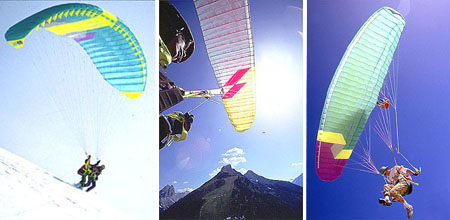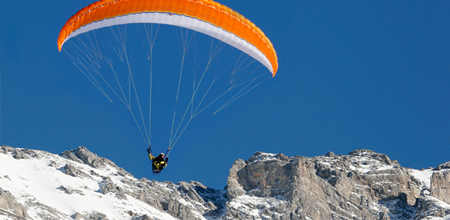Designed in Austria since 1986
PRO-DESIGN is considered a pioneer in paragliding since the beginning of the sport, and can look back at almost thirty years of experience and development work. We invented special construction and manufacturing techniques which have become standards in today's paraglider development field. Only the highest quality and strictest safety tests go in to all of our products
On top from the very beginning...
Due to our comprehensive knowledge in the development of paragliders from the very beginning, we can take all initial difficulties into consideration when making improvements or designing new products
PRO-DESIGN is a pioneer in creating special construction techniques and ideas, which have become standard in today's paraglider development field. Supreme aims for our designs and developments are best performance, highest quality and matching all safety standards. Smart and innovative concepts, latest manufacturing techniques, the use of highest quality materials and proven and strict safety tests guarantee for a good product
PRO-DESIGN's designer is Alexandre Paux. He is the initiator of new ideas. But only the cooperation of the entire team will create a product from the initial idea. The finalized series product is the result of the harmonizing cooperation of our whole team








PRO-DESIGN – pioneer for new ideas and developments!
We can look back on a lot of pioneering and own developments, which pointed the way ahead and which have been taken over from others, meanwhile being used in general paraglider constructions, such as:
The use of cloth materials with different features, durable and strong fabric for top surface, light-weight fabric for the bottom surface to save weight and firm fabric for the ribs to achieve best possible shape.
(This concept was already used 1986 for the COMBI-CUT 11, the first PRO-DESIGN series glider!)
Attaching reinforcement tapes to the ribs, starting from the line attachment points on the bottom surface and going to the top surface to achieve the best possible load-distribution as well as maximum strength.
(This concept was already used 1986 for the COMBI-CUT 11, the first PRO-DESIGN series glider!)
V-rib-construction to reduce the number of lines needed. This reduces the aerodynamic drag caused by the lines, resulting in an improvement of performance.
(This concept was first used already in 1987 in development stage for the THERMIK 268, successor of the COMBI-CUT 11.)
Stabilizers vented from the inside. Aerodynamically efficient and fully profiled wingtips.
(Concept already first used in 1987 on the pre-series of our successful model KESTREL.)
The use of progressively differing line diameters instead of only using one line Type. This allows for maximum overall strength and the lowest possible drag.
(Concept first used in 1989 in the development stages for the Corrado CHALLENGER.)
Partial V-technology: This system solves the weight problem of conventional V-cell designs. The V-ribs distribute the load fully to the top surface, yet taper down to the attachment points.
(Concept was first used in 1994 on the world champion glider HIGH 68.)
Reinforcement tape
A special tape running span-wise near the trailing edge reduces oscillation and allows for above average in-flight stability.
Ram-Air pockets at the inside of the leading edge on the lower sail reduce disturbing vibrations and stabilise the glider at high speed.
TETS-brake-line-attachments for more efficiency on the brake-effect and optimising the tension on the trailing edge with minimum brakelines necessary.
HR-Speedsystem for a large speed-range and top performance at high speeds.
Differing line diameters/ Splitline
The special PRO-DESIGN line concept with progressively differing diameters allows for maximum overall strength and the lowest possible drag. Another important new development from PRO-DESIGN is the new pre-stretched and bend-insensitive Dyneema line. These highly durable lines have an increased breaking strength while remaining consistent in length.
A special A-folding line for easily doing big-ears is also standard.
The creation of specific construction techniques and smart solutions. For example: safety inserts on the riser links, or special hooks on the speed system to connect the stirrup to the risers.
